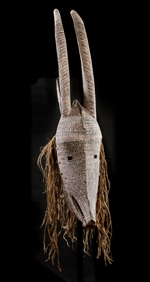West African Sculpture: Selections from the Mary Johnston Collection
March 24 – June 3, 2012
Traditional African sculpture is central to tribal life and thought. It includes objects of daily life, such as exquisitely carved chests, stools, headrests, walking sticks, pulleys, combs, dolls, and spoons, as well as figurative sculptures intended to praise powerful kings and tribal chiefs, or made to be placed in home altars and village shrines to honor ancestors or to intercede on a petitioner’s behalf. In addition, it includes various types of masks, intended to be worn during initiation rites, harvest festivals, religious ceremonies, funerals, and masquerades.
West African Sculpture: Selections from the Mary Johnston Collection feature masks, sculptures and other objects found among the tribes of West Africa, including the Bambara and Dogon of Mali, the Bobo of Burkina Faso, the Senufo and Baule of the Ivory Coast, the Ashanti of Ghana, the Idoma and Ejagham of Nigeria, and the Bamileke of Cameroon, among others. Organized by Director John Olbrantz, the exhibition opens March 24 and continues through June 3, 2012, at the Hallie Ford Museum of Art at Willamette University.
The exhibition is drawn exclusively from the collection of Mary Johnston of Florence, Ore. Johnston, who holds degrees from the University of Oregon in anthropology and psychology, inherited the collection from her brother who acquired it in Berlin, Germany in the early 1970s. When she saw the collection for the first time, she was immediately intrigued by the beauty and vitality of the pieces and has devoted the last 20 years of her life to their study.
West African Sculpture: Selections from the Mary Johnston Collection has been supported in part by grants from the City of Salem’s Transient Occupancy Tax funds and the Oregon Arts Commission.

